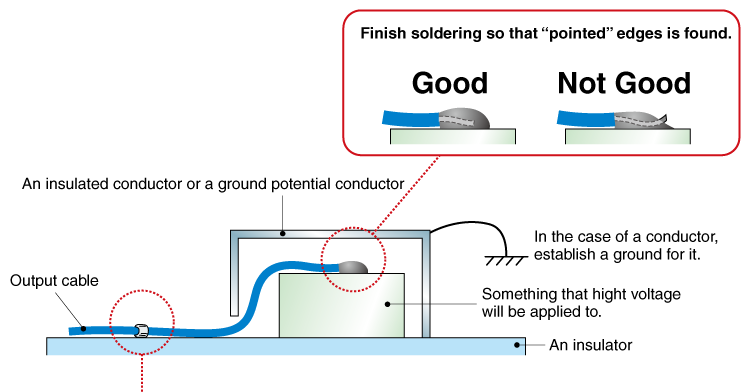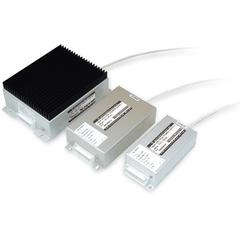High-voltage power supplies must be handled with care.
"We use ours carefully, so we'll be fine."
"We never had any problems, so we're probably ok."
But, are you sure there is nothing you've neglected or overlooked?
Let Matsusada Precision, which specializes in the manufacture of high-voltage power supplies, show you the correct way to use a high-voltage power supply.
Safety and Usage of High Voltage Power Supply #1
To prevent discharging
Even in insulators, various discharge phenomena are likely to occur as the applied voltage increases. Therefore, when handling high voltage, it is necessary to perform withstand voltage testing to ensure safety. Withstand voltage is determined by the creepage distance and insulation distance of the insulator, as well as the shape of the electrode.
- Creepage distance: The distance along the surface of an insulator between two conductive parts.
- Insulation distance: The thickness of the insulator when the conductive parts are completely covered by the insulator.
Generally, withstand voltage decreases because of humidity and dirt/dust. As a result, discharge and leakage are more likely to occur as the voltage increases. Therefore, it is crucial to choose an appropriate insulating material for the operating voltage so that the insulation can be maintained for longer.
Several insulation methods are described below.
| Air insulation |
When conductive parts are exposed to the air, it has insulation properties of approximately 500 V/mm under dry conditions. However, these insulation properties are adversely affected by humidity, dust, salt, and hazardous gas, and therefore countermeasures are required.
|
|---|---|
| Gas insulation |
SF6 gas is commonly used. It has high dielectric strength and is chemically stable up to a gas temperature of 1800 K. Moreover, SF6 has a withstand voltage of approximately 8 kV/mm. |
| Liquid insulation |
Petroleum oils, silicon oils, and fluorinated oils are a few examples of insulation oils. |
| Solid insulation |
If the operational voltage is 3 kV or less, most resin materials (with high insulation resistance) can be used. At 10 kV or more, we recommend the use of materials with superior insulation properties.
|
Safety and Usage of High Voltage Power Supply #2
Handling high voltage output cables
There are several ways to form connections when applying a high voltage. Here, we describe examples and precautions for handling high-voltage cables.
For direct soldering
To prevent bodily harm during electricity discharging, either cover the object with an insulator with sufficient dielectric strength, or cover it with an object that has ground potential so that electricity is discharged to the ground, not a different location.

Connecting high voltage cables
When creating a high-voltage line by connecting high-voltage cables, it is difficult to keep the cables connected by simply linking them together, as described above. Therefore, it is important to cover the connections with heat-shrink tubing that has dielectric strength. Note that there is a risk of dielectric breakdown in the tube if its withstand voltage is insufficient.
If the insulation withstand voltage of a single tube is insufficient, use double or triple tubes to ensure sufficient withstand voltage. However, dielectric breakdown might occur if there are rough surfaces on the solder, even if the tube has sufficient insulation withstand voltage. Please ensure to make rounded solder joints.

Smooth the soldered area to ensure no "pointed" edges are visible.


Safety and Usage of High Voltage Power Supply #3
Items that require particular attention
When handling high voltage, failure to observe safety precautions can result in electric shock, or even death. It is critical to carefully follow the following safety precautions.
1. Always connect a ground wire
To prevent electrocution during electricity discharging, either cover the conductive part with an insulator with sufficient dielectric strength, or cover it with an object with ground potential so that electricity is not discharged to a different location.
2. Do not touch high voltage areas
During the operation of high-voltage equipment, avoid contact with parts with high-voltage outputs and high-voltage terminals.
Carelessness can result in electric shocks. During normal operation and test operation, extremely high voltages are applied to the terminals. Thus, accidentally touching them or coming into contact with them can be fatal.
3. Cover high voltage areas
With high voltages of 300 V or more, there is a risk of electric shock due to the discharge of electricity, even if you do not directly touch an electrode. Therefore, to ensure that these areas cannot be touched directly, it is important to either cover electrodes and other high-voltage areas with insulators with sufficient dielectric strength, or cover them with a grounded conductive material.

Use insulators having high insulation property

Never touch stripped wire
4. Share an awareness of danger
Considering the high risk of electric shock accidents, it is best to avoid any contact with high voltage power supplies if personnel who are experienced in the operation of high voltage power supplies and who know how to perform appropriate first aid measures are not nearby. Moreover, if inexperienced personnel are operating a high-voltage power supply, explain the necessary precautions in advance (such as wearing safety equipment and avoiding contact with hazardous areas) and ensure they completely understand the dangers before performing operations.
5. Perform operations with your right hand
To reduce the risk of electric current flowing through the important organs of the body in the event of an electric shock, be sure to operate high-voltage power supplies using only the right hand while keeping the left hand away from the high-voltage power supply and all other equipment.
6. Turn off the power before touching equipment
Importantly, turn off the power before touching any high-voltage areas. Additionally, make sure that the power is completely turned off. Moreover, there are capacitors in the output area, which makes it extremely dangerous to touch such areas immediately after the power has been turned off. Pay careful attention to the electric charge in these capacitors while grounding them to discharge the electricity.
7. Pay attention to electric charge in cables
The energy that is charged in output-shielded cables is discharged by grounding. However, in some cases, when the ground is disconnected, the charge may not completely discharge, or the charge might be recovered after some time. Therefore, be sure to completely remove all charge from output cables before touching them.

8. Disconnect the input line before touching
If you have to touch the inside of the power supply for some reason, ensure to follow the instruction manual and turn off the power before disconnecting the input line. Additionally, all capacitors and devices that generate high voltages must be grounded.
In case there is no procedure described in the instruction manual, never remove the cover, and do not touch the inside of the power supply.
9. Instruct others to pay careful attention
To prevent people from entering hazardous areas or inadvertently coming into contact with high-voltage areas, it is important to clearly mark hazardous areas with high-voltage signs and instruct others to pay careful attention to the dangers of high-voltage. Additionally, when a high voltage is generated, issue a HIGH VOLTAGE WARNING using a warning lamp or an audible alarm.

Danger! HIGH VOLTAGE

Electric Shock
Electric shock or electrocution refers to the flow of electric current through the human body. The degree of electric shock is related to the magnitude of the current that flows through the body and the path through which the current flows. Generally, weak currents produce only a tickling feeling; however, such currents can also cause burns, respiratory problems, cardiac impairment, or in the worst case, death.
For a voltage of 100 V, the resistance of human skin is approximately 5 kΩ in dry conditions. In wet conditions, it drops to approximately 2 kΩ. The resistance of the human body is approximately 300 Ω. If you come into contact with 100 V while your skin is wet, approximately 22 mA of electric current will flow through your body and you will be unable to let go.
This is why performing any operations with wet hands is strictly prohibited.
| Electric current value | Effect on the human body |
|---|---|
| 1 mA | Mild tingling |
| 5 mA | Considerable pain |
| 10 mA | Unbearable pain |
| 20 mA | Intense muscular contraction, unable to break away from the circuit on one's own |
| 50 mA | Considerably dangerous |
| 100 mA | Fatal outcomes |
These numerical values are conceptual. The danger will be less if only a weak current flows, either because the power supply's current is extremely small or the circuit's impedance (similar to resistance) is large. As the voltage increases, the air insulation is broken and electricity is discharged, leading to an elevated risk of electric shock even without coming into direct contact with an electrode. Therefore, it is important to maintain a safe distance from charged areas, as listed in the following table.
Care must be taken to avoid approaching these charged areas.
Table: Safety distance to voltage of charged area
| Voltage of charged area (kV) | 3 | 6 | 10 | 20 | 30 | 60 | 100 | 140 | 270 |
|---|---|---|---|---|---|---|---|---|---|
| Safety distance (cm) | 15 | 15 | 20 | 30 | 45 | 75 | 115 | 160 | 300 |
First Aid for Electric Shock
Rescue
Immediately move the victim away from the conductor through which the current is flowing. Simultaneously, avoid direct contact with both the conductor through which the electric current is flowing and the body of the victim to avoid becoming electrocuted. Immediately turn off the high-voltage power supply and ground the circuit. If the high-voltage power supply cannot be turned off, either ground the circuit or use an axe (ax) with a dry wooden handle to cut the input and output cables. In such a scenario, take care that electric sparks are not discharged from the cables. If it is not possible to either turn off or ground the circuit, use an insulator, such as a dry board or clothing, to rescue the victim. Call an ambulance immediately.
Symptoms
Do not confuse the symptoms of electric shock with death. Besides severe burns, the symptoms of electric shock include unconsciousness, respiratory arrest, cardiopulmonary arrest, paleness, and rigidity.
Treatment
- If the victim is not breathing properly, start administering artificial respiration on the spot. Note that the victim should be moved to a safe location only if the lives of the victim or rescuers are in danger by remaining at the site of the accident.
- If you start artificial respiration, continue performing artificial respiration correctly either until the victim begins breathing again on their own, or until medical professionals take over.
- If another person is available, take turns performing artificial respiration continuously, without interrupting the rhythm. The electric shock might also cause internal burns, which can lead to serious consequences if left untreated.
Therefore, in addition to first aid, it is important to have the victim examined by a physician as soon as possible.
Although we have described the measures that should be taken in the event an accident occurs, it goes without saying that the best action is to prevent accidents from occurring. Please develop a thorough understanding of the dangers of high voltage and use high voltage power supplies both safely and correctly to ensure that electric shock accidents never occur.
Recommended products
Matsusada Precision has provided safe and reliable high-voltage power supplies and high-voltage amplifiers to worldwide customers for many years.






